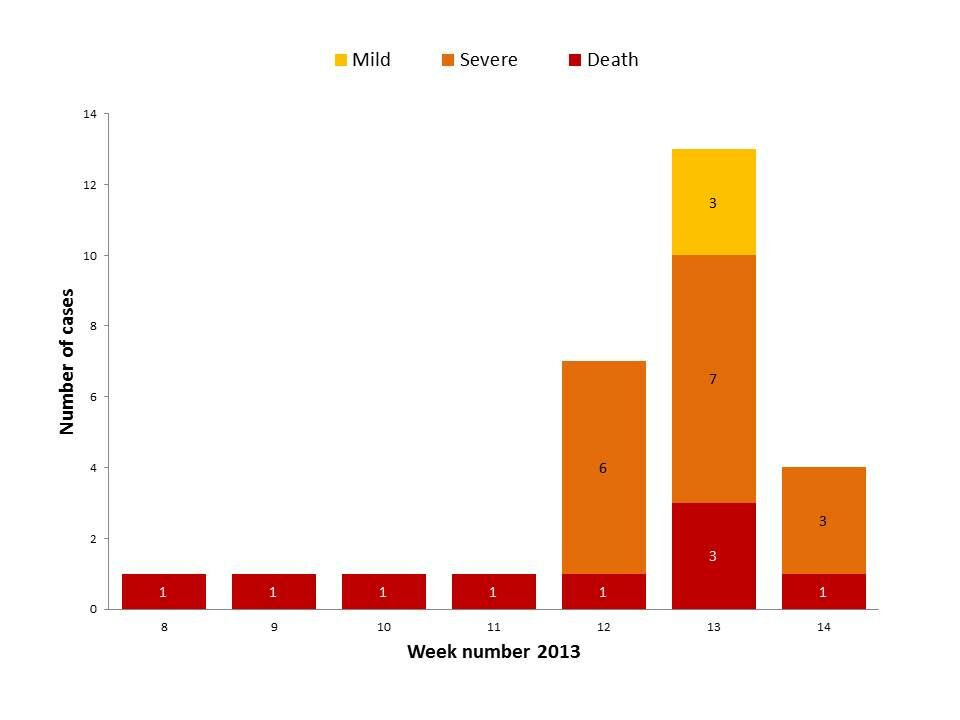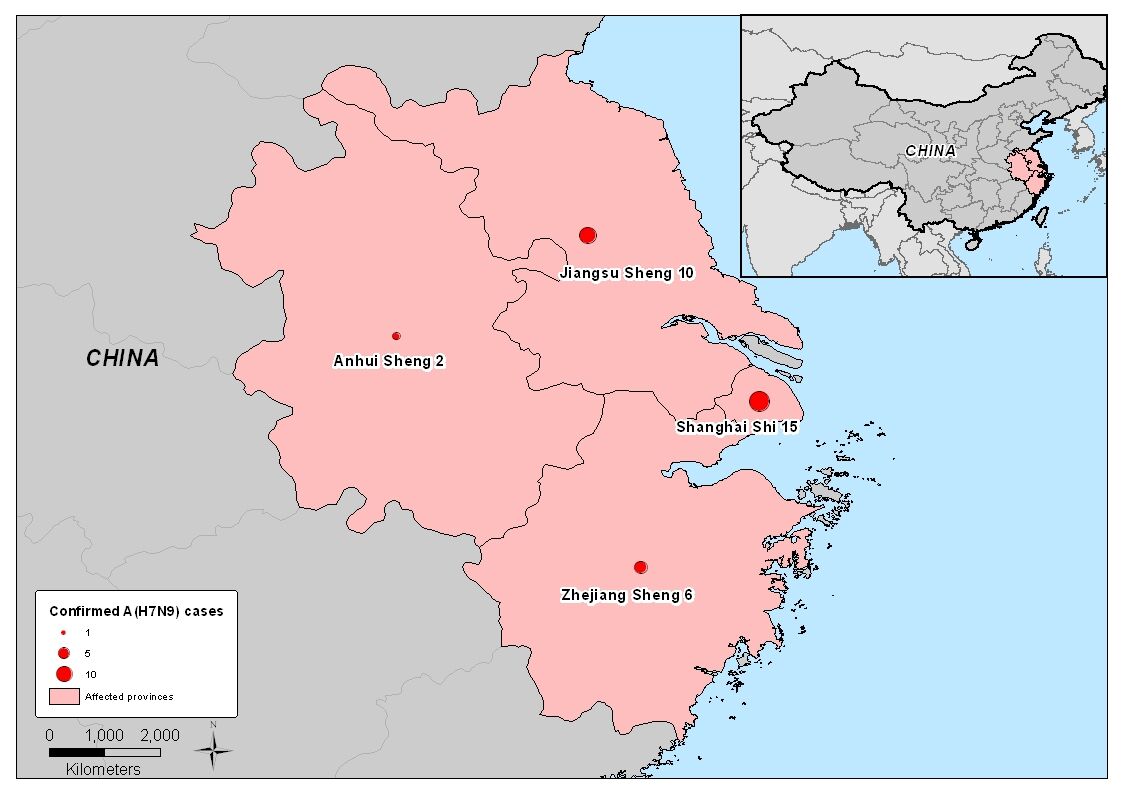Epidemiological update of 11 April: novel influenza A virus A(H7N9) in China
As of 10 April 2013, 33 human cases of infection with influenza A(H7N9) virus have been reported in four provinces of China: Shanghai (15), Jiangsu (10), Zhejiang (6) and Anhui (2). Of these cases, nine people have died, 21 are severe cases and three are mild cases. No epidemiological link has been identified among cases.
On 31 March 2013, the Chinese health authorities announced that they identified a novel influenza A(H7N9) virus in three seriously ill patients.
As of 10 April 2013, 33 human cases of infection with influenza A(H7N9) virus have been reported in four provinces of China: Shanghai (15), Jiangsu (10), Zhejiang (6) and Anhui (2). since 31 March 2013, with onset of disease between 19 February and 3 April 2013. The date of disease onset is currently unknown for five patients. Nine patients died (case-fatality ratio=27%), 21 are severe cases and three are mild cases. The median age is 64 years with a range between 4 and 87 years; 11 of them are females.
No epidemiological link has been identified among cases. Almost 700 close contacts of the confirmed cases are being closely monitored. There are reports of a potential small family cluster of disease around the first case, but this has not been confirmed by laboratory data. In Jiangsu, investigation is on-going into a contact of an earlier confirmed case who developed symptoms of illness.
The source of these infections and the mode of transmission are yet to be determined. This is the first time that human infection with influenza A(H7N9) virus has been identified.
The Chinese health authorities are responding to this public health event by enhanced surveillance, epidemiological and laboratory investigation and contact tracing. The animal health sector has intensified investigations into the possible sources and reservoirs of the virus. The authorities reported to the World Organisation for Animal Health (OIE) that A(H7N9) was detected in samples from pigeons and chickens and in environmental specimens from three markets in Shanghai. These markets have been closed and the live poultry were culled.
The influenza A viruses from the first three cases were non-subtypeable and were sent to the WHO Influenza Collaborating Centre at the Chinese Centre for Disease Control and Prevention (CCDC). The genetic comparison indicated that these cases were caused by a novel reassortant avian influenza virus with avian origin genes from both A(H7N9) and A(H9N2). No similar viruses have been seen before and A(H7N9) differs from A(H7) and A(H9) viruses that have been seen previously in Europe.
No vaccine is currently available for this subtype of the influenza virus. Preliminary test results suggest that the virus is susceptible to the neuraminidase inhibitors (oseltamivir and zanamivir).
At this time there is no evidence of on-going human-to-human transmission and there has not been further geographical spread. More sporadic cases are expected to be reported. The risk of disease spread to Europe is considered low, although individual cases coming from China cannot be ruled out.
Figure 1: Distribution of influenza A(H7N9) cases by date of onset, age, gender, status and province, China, as of 10 April 2013 (n=33)*
Date of onset |
Age |
Sex |
Status |
Severity |
Province |
19/02/2013 |
87 |
M |
dead |
severe |
Shanghai |
27/02/2013 |
27 |
M |
dead |
severe |
Shanghai |
07/03/2013 |
38 |
M |
dead |
severe |
Zhejiang |
15/03/2013 |
35 |
F |
dead |
severe |
Anhui |
19/03/2013 |
45 |
F |
alive |
severe |
Jiangsu |
19/03/2013 |
48 |
F |
alive |
severe |
Jiangsu |
20/03/2013 |
83 |
M |
dead |
severe |
Jiangsu |
20/03/2013 |
61 |
F |
alive |
severe |
Jiangsu |
21/03/2013 |
32 |
F |
alive |
severe |
Jiangsu |
21/03/2013 |
79 |
M |
alive |
severe |
Jiangsu |
22/03/2013 |
67 |
F |
alive |
severe |
Shanghai |
25/03/2013 |
67 |
M |
alive |
severe |
Zhejiang |
25/03/2013 |
59 |
M |
alive |
severe |
Shanghai |
27/03/2013 |
52 |
F |
dead |
severe |
Shanghai |
28/03/2013 |
48 |
M |
dead |
severe |
Shanghai |
28/03/2013 |
74 |
M |
alive |
severe |
Shanghai |
28/03/2013 |
55 |
M |
alive |
severe |
Anhui |
28/03/2013 |
85 |
M |
alive |
severe |
Jiangsu |
29/03/2013 |
64 |
M |
dead |
severe |
Zhejiang |
29/03/2013 |
66 |
M |
alive |
mild |
Shanghai |
29/03/2013 |
67 |
M |
alive |
mild |
Shanghai |
29/03/2013 |
70 | M | alive | severe | Jiangsu |
30/03/2013 |
25 |
F |
alive |
severe |
Jiangsu |
31/03/2013 |
4 |
M |
alive |
mild |
Shanghai |
01/04/2013 |
64 |
M |
dead |
severe |
Shanghai |
01/04/2013 |
62 |
M |
alive |
severe |
Shanghai |
02/04/2013 |
74 |
M |
alive |
severe |
Jiangsu |
03/04/2013 |
77 |
M |
alive |
severe |
Shanghai |
51 |
F |
alive |
severe |
Zhejiang | |
79 |
M |
alive |
severe |
Zhejiang | |
65 |
M |
alive |
severe |
Zhejiang | |
76 |
F |
alive |
severe |
Shanghai | |
81 |
F |
alive |
severe |
Shanghai |
*Date of onset is currently unknown for five patients.
Figure 2: Distribution of influenza A(H7N9) cases by week of onset of symptoms, China, as of 10 April 2013 (n=28)

Figure 3: Distribution of cumulative number of influenza A(H7N9) cases by province, China, 19 February – 10 April 2013








